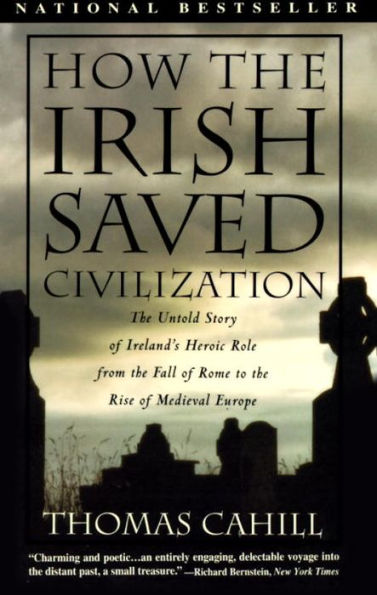The perfect St. Patrick's Day gift, and a book in the best tradition of popular history — the untold story of Ireland's role in maintaining Western culture while the Dark Ages settled on Europe.
Every year millions of Americans celebrate St. Patrick's Day, but they may not be aware of how great an influence St. Patrick was on the subsequent history of civilization. Not only did he bring Christianity to Ireland, he instilled a sense of literacy and learning that would create the conditions that allowed Ireland to become "the isle of saints and scholars" — and thus preserve Western culture while Europe was being overrun by barbarians.
In this entertaining and compelling narrative, Thomas Cahill tells the story of how Europe evolved from the classical age of Rome to the medieval era. Without Ireland, the transition could not have taken place. Not only did Irish monks and scribes maintain the very record of Western civilization — copying manuscripts of Greek and Latin writers, both pagan and Christian, while libraries and learning on the continent were forever lost — they brought their uniquely Irish world-view to the task.
As Cahill delightfully illustrates, so much of the liveliness we associate with medieval culture has its roots in Ireland. When the seeds of culture were replanted on the European continent, it was from Ireland that they were germinated.
In the tradition of Barbara Tuchman's A Distant Mirror, How The Irish Saved Civilization reconstructs an era that few know about but which is central to understanding our past and our cultural heritage. But it conveys its knowledge with a winking wit that aptly captures the sensibility of the unsung Irish who relaunched civilization.
The perfect St. Patrick's Day gift, and a book in the best tradition of popular history — the untold story of Ireland's role in maintaining Western culture while the Dark Ages settled on Europe.
Every year millions of Americans celebrate St. Patrick's Day, but they may not be aware of how great an influence St. Patrick was on the subsequent history of civilization. Not only did he bring Christianity to Ireland, he instilled a sense of literacy and learning that would create the conditions that allowed Ireland to become "the isle of saints and scholars" — and thus preserve Western culture while Europe was being overrun by barbarians.
In this entertaining and compelling narrative, Thomas Cahill tells the story of how Europe evolved from the classical age of Rome to the medieval era. Without Ireland, the transition could not have taken place. Not only did Irish monks and scribes maintain the very record of Western civilization — copying manuscripts of Greek and Latin writers, both pagan and Christian, while libraries and learning on the continent were forever lost — they brought their uniquely Irish world-view to the task.
As Cahill delightfully illustrates, so much of the liveliness we associate with medieval culture has its roots in Ireland. When the seeds of culture were replanted on the European continent, it was from Ireland that they were germinated.
In the tradition of Barbara Tuchman's A Distant Mirror, How The Irish Saved Civilization reconstructs an era that few know about but which is central to understanding our past and our cultural heritage. But it conveys its knowledge with a winking wit that aptly captures the sensibility of the unsung Irish who relaunched civilization.

How the Irish Saved Civilization: The Untold Story of Ireland's Heroic Role from the Fall of Rome to the Rise of Medieval Europe
256
How the Irish Saved Civilization: The Untold Story of Ireland's Heroic Role from the Fall of Rome to the Rise of Medieval Europe
256Related collections and offers

Product Details
| ISBN-13: | 9780385418492 |
|---|---|
| Publisher: | Knopf Doubleday Publishing Group |
| Publication date: | 02/01/1996 |
| Series: | Hinges of History Series , #1 |
| Pages: | 256 |
| Sales rank: | 7,858 |
| Product dimensions: | 5.18(w) x 8.00(h) x 0.54(d) |
About the Author
What People are Saying About This
Customer Reviews
Explore More Items
For fans of the great detective, this volume collects 10 classic tales of mystery and detection. In addition to the complete short novel “The Hound of the Baskervilles,” it includes
Horror hides behind an attractive face in The Picture of Dorian Gray, Oscar Wilde's tale of a notorious Victorian libertine and his life of evil excesses. Though Dorian's hedonistic
Lewis Carroll's novels Alice's Adventures in Wonderland and Through the Looking-Glass (first published in 1865 and 1871, respectively) have entertained readers young and old for more than a
Erik Larson—author of #1 bestseller IN THE GARDEN OF BEASTS—intertwines the true tale of the 1893 World's Fair and the cunning serial killer who used the fair to lure his victims to their
Erik Larson has been widely acclaimed as a master of
In Thunderstruck, Erik Larson tells the interwoven stories of two men—Hawley Crippen, a very
It began in 1692, over an exceptionally raw Massachusetts winter, when a
In this dazzling work of history, a Pulitzer Prize-winning author follows Benjamin Franklin to France for the crowning achievement of his career
"In December of 1776 a small boat delivered an old man
More than simply sustenance, food historically has been a kind of
Social media is anything but a new phenomenon. From the
